


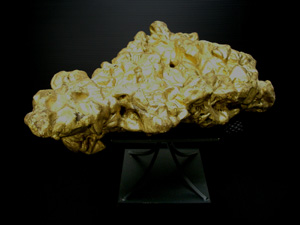
金塊レプリカ
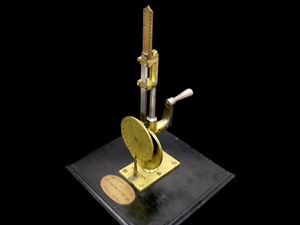
ハートカム

マゼランペンギン
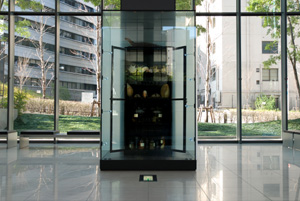
大ケース全景(ガラス・ケースの中に歴史的な鉄製ケース)
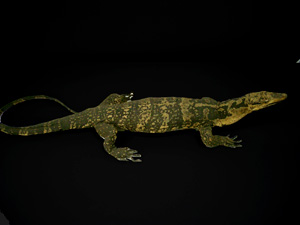
ミズオオトカゲ
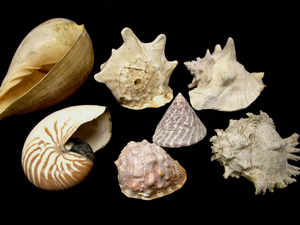
貝類
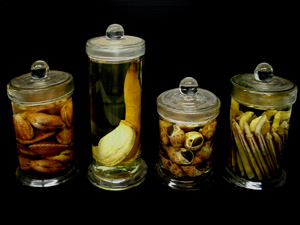
貝類
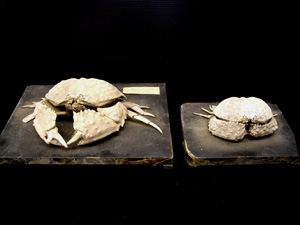
カラッパ
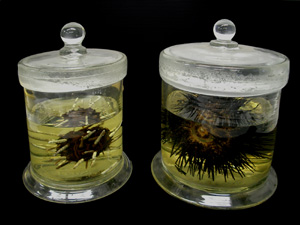
ウニ類
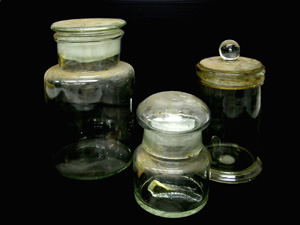
ガラス器具
 展示標本 (2007.1.17-2007.7.20)
展示標本 (2007.1.17-2007.7.20) 小ケース1: 金塊レプリカ
1842年ロシアで採掘された当時世界最大の金塊(約40kg)のレプリカ。ドイツの著名な鉱物標本商であるクランツ商会において製造された。レプリカではあるが、掘り出されたときの「かたち」をとどめるものとして貴重である。
Replica of gold nugget
Replica of gold nugget excavated in Russia in 1842, which was the biggest (about 40 kg) at that time. This replica was produced by Dr. Krantz, a famous mineral specimen company in Germany. Such replica has academic value as a record of the three dimensional original form.
小ケース2: ハートカム
原節(カム)の回転運動に対して従節が規則的に従動する、カムと呼ばれる基本的な動力伝達機構のひとつ。本模型は明治初頭工部省工学寮において教育用の教材として使われていた。カムの回転中心から端部までの距離が角度に比例していることから、原節(カム)の角速度が一定のとき、従節の速度が一定となる。
Heart profiled cam mechanism
A type of fundamental mechanisms called “cam” consisted of a driver (cam) rotating around a fixed axis and a follower accompanying it regularly. This model served for educational use in the Imperial College of Engineering in the early Meiji era. The follower's velocity becomes constant for the driver's constant angle velocity due to the proportional increase of the distance from the center to the cam’s edge.
小ケース3: マゼランペンギン
ペンギンは海の生活に特化した鳥類で、空は飛べない。羽はフリッパーというひれ状のもので、尾も脚も短く泳ぐためのものになっており、胴体は水の抵抗を小さくするために紡錘形である。このため魚やイルカなどと似た体型をしている。胸骨の竜骨突起がよく発達している。陸上では胴体を垂直にたてる点で他の鳥と違う。魚類や軟体動物などを食べる。マゼランペンギンは体長70cmほどの中型のペンギンであり、南アメリカ南部の海岸にすむ。アルゼンチンのプンタ・トンボ保護区はマゼランペンギンが集まることで有名で、繁殖期には50万羽ものペンギンが集まる。ふだんは海を泳いでくらしているが、繁殖期には上陸し、2つの卵を産む。卵は雌雄であたためる。1ヶ月ほどで孵化し、2ヶ月ほどで大人になる。一夫一妻で、その絆は長く続く。
Magellanic penguin(Spheniscus magellanicus)
Penguins are a bird group which are specialized to live in the sea. They cannot fly but swim using flippers. In order to swim smoothly in water, their tails and legs are short and the body is streamlined. Their body shape shows convergence with fishes and dolphins according to the needs of sea life. Penguins are different from other birds as when they stand on the land, they set their bodies vertical. They eat sea foods such as fishes, squids, and shrimps.
The Magellanic penguin (Spheniscus magellanicus) is a middle sized penguin (70cm body length) living in the southern South America. Punta Tombo Reserve is famous for this penguin where as many as 500 thousands of birds breed. They live in the sea usually, but come to breeding places in September and October. They usually lay two eggs, and both the father and the mother warm them for a month. Chicks become adults two months after hatch. The couple bond is strong and continues long.
大ケース: 水圏に関わる動物学標本
1877年東京大学理学部動物学教室初代教授となったエドワード・モースは、大学における動物学標本収集の意義を強調した。以来130年近くにわたって収集が続けられてきた動物学標本のうち、とくに水圏に関わるものを集めた。
Zoological specimens related to water
Edward Morse, became the first Professor of the faculty of zoology, department of science, the University of Tokyo in 1877, emphasized the importance of collecting zoological specimens in the University. These are part of such specimens, especially related with water, collected for almost 130 years since then.
大ケース内の展示標本
ミズオオトカゲ
東南アジアに広く分布する大型のトカゲ。最大で2m30cmに達する。川辺に生息し、遊泳能力がある。肉食で、昆虫、カニ、魚類、カエル、鳥類を捕食する。
Varanus salvator
Varanus salvator is a large lizard attaining 230 cm and distributed widely in Southeast Asia. It lives around the river, actively swims, and eats insects, crabs, fishes, frogs, birds, etc.
貝類
東京帝国大学理学部動物学教室によって収集された貝類標本の代表例。動物学教室では1870年代以降様々な動物標本を網羅的に収集したが、その中でも貝類は最大の規模をもつ。海外の研究機関との交換によって世界中から標本を集めた他、関係者を南洋諸島に派遣して熱帯性の貝類も多数収集した。
Molluscan shells
Representative specimens of molluscan shells collected by Zoological Institute, Tokyo Imperial University. The institute started collecting various animals in the 1870s, and the shell collection constituted the largest part. Specimens from all regions of the world were obtained through exchange with foreign institutes. Numerous tropical shells were also collected from Pacific islands by university staffs.
カラッパ
カラッパは大きく膨らんだ甲を持つカニ類の1種である。砂に潜って生活し、貝類の貝殻を強靱なはさみで破壊して捕食する。はさみ脚で口をおおっていることから、カラッパ類を英語でshamefaced crab(内気なカニ)と呼ぶ。
Clappa
Clappa is a group of crabs having an inflated carapace. They burrow in sands and prey on shells with robust craws. English name “shamefaced crab” is derived from their characteristic behavior to conceal the mouth with the craws.
ウニ類
ナマコやヒトデに近縁な棘皮動物のグループのひとつ。体は円形で、硬い殻を持ち、石灰質の鋭い棘で覆われる。棘は体の防御の他、移動の際の運動器官として用いられる。多くの種は岩礁に生息し、海藻を主食とする。生殖巣が食用に利用される。
Sea urchins
Sea urchins are one of large groups of Echinodermata and closely related to sea cucumbers and sea stars. The animal is rounded in outline, supported by a hard test, and covered with numerous calcareous spines. The spines are used for body protection and also as a locomotory organ. Most species live on the rock surface and feed on sea weeds. The gonads of some species are used as sea food.
ガラス器具
大学で使われてきた古いガラス器具は独特の機能美を有している。総合研究博物館ではそれらを回収しデザイン資源として再活用している。
Glass instruments
Old glass instruments served for academic use have unique functional beauty. So they are collected and reused as design resources in the University Museum, the University of Tokyo.
鉄製ケース
昭和初年にロックフェラー財団の援助によって震災復興された総合図書館で使われていたもの。取っ手の意匠に特徴がある。
Steel case
Steel case used in the General Library of the University of Tokyo reconstructed with the aid of Rockefeller Foundation in the early Showa era after the Great Earthquake, which has characteristically designed knob.
解説文執筆
高槻成紀 (本館教授、動物生態学) Seiki Takatsuki (Professor)
佐々木猛智 (本館助手、動物分類学) Takenori Sasaki (Assistant professor)
藤尾直史 (本館助手、建築史学) Tadashi Fujio (Assistant professor)
写真撮影
松本文夫 (本館客員准教授) Fumio Matsumoto (Affiliate associate professor)
展示期間別の標本解説
2007年1月〜2007年7月
2007年7月〜2008年2月
2008年2月〜2008年8月
2008年8月〜2009年2月
2009年2月〜2009年7月
2009年8月〜2010年1月
2010年2月〜2010年7月
2010年8月〜2011年1月
2011年1月〜2011年7月
2011年8月〜2012年1月
2012年1月〜2012年7月
2012年8月〜2013年2月
2013年2月〜2013年8月
2013年8月〜2014年1月
2014年2月〜2014年11月
2014年11月〜2015年7月
2015年8月〜2016年1月
2016年2月〜2016年7月
今までのトップページの連続スライドショー
興和不動産本社におけるモバイルミュージアム(非公開)
ページの先頭に戻る